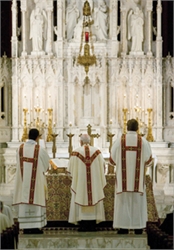
Jeg tenker stadig mye på om det er mest passende at presten ser på menigheten når han bærer fram messens hellige offer, og kommer stadig tydeligere til den konklusjonen at det er det ikke. Jeg skal prøve å formulere noen grundigere tanker om dette om ikke lenge, og da betgynne med å vise at det er en misforståelse (som mange trodde fram til 80-tallet, og som dessverre flere fortsatt tror) å tro at i den første kristne tid feiret man messen rundt et bord, med biskopen/presten vendt mot de troende.
I denne omgang vil jeg bare (på nytt) nevne biskop Slattery i Tulsa, Oklahoma, som i september 2009 sluttet å feire messen vendt mot menigheten i sin egen domkirke, og som i forindelse med det skrev:
Because the Mass is so necessary and fundamental to our Catholic experience, the liturgy is a constant topic in our conversation. That is why when we get together, we so often reflect upon the prayers and readings, discuss the homily, and – likely as not – argue about the music. The critical element in these conversations is an understanding that we Catholics worship the way we do because of what the Mass is: Christ’s sacrifice, offered under the sacramental signs of bread and wine.
If our conversation about the Mass is going to “make any sense,” then we have to grasp this essential truth: At Mass Christ joins us to Himself as He offers Himself in sacrifice to the Father for the world’s redemption. We can offer ourselves like this in Him because we have become members of His Body by Baptism.
We also want to remember that all of the faithful offer the Eucharistic Sacrifice as members of Christ’s body. It’s incorrect to think that only the priest offers Mass. All the faithful share in the offering, even though the priest has a unique role. He stands “in the person of Christ,” the historic Head of the Mystical Body, so that at Mass, it is the whole body of Christ – Head and members together that make the offering. …
I fortsettelsen av denne noe overraskende innledningen (overraskende fordi han legger stor vekt på de troende) argumenterer han videre med at biskopen/ presten og menigheten derfor bør vende seg samme vei. Jeg tar med mer av hans argumentasjon om ikke lenge, men les gjerne selv hans artikkel her.
